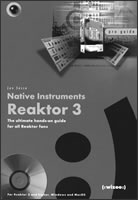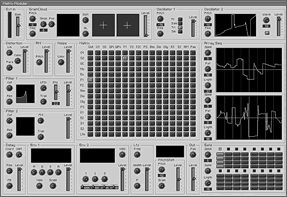Len Sasso: Native Instruments Reaktor Wizoo Guide
US$ 499.00; available from Native Instruments Software Synthesis, GmbH, Schlesische Strasse 28, D-10997 Berlin, Germany; telephone (+49) 30-611-035-30; fax (+49) 30-611-035-35; electronic mail info@native-instruments.de; Native Instruments USA, 6477 Almaden Expressway, Suite D2-F8, San Jose, California 95120, USA; telephone (+1) 800-665-0030; fax (+1) 408-266-6591; electronic mail info@native-instruments.com; World Wide Web www.native-instruments.com/.
Softcover, 2002, ISBN 3-934903-40-1, 228 pages, appendix, index, CD-ROM, US$ 34.95; Wizoo GmbH, Bremen, Germany; www.wizoo.com/.
Reviewed by Jonathan Segel
Oakland, California, USA
 Reaktor 3
Reaktor 3
Reaktor, Version 3, is Native Instruments’ premiere software synthesizer. As such it is a very large collection of tools that allows the user to build their own synthesizers, sample manipulators, sequencers, and effects processors, utilizing a vast array of pre-made modules and objects as building blocks.
The manual that comes with the application contains some how-to information, but its strength is that it holds a large reference compendium of the available objects, their functions and uses. Len Sasso’s Reaktor 3 Guide, written for Wizoo, is the appropriate how-to manual to fill in the gaps and get the user started on the road to creating their own instruments.
In Reaktor 3, a patch or instrument is always
represented on two levels: the front level is a GUI panel that mimics
a machine
interface, where
the controller knobs, buttons and sliders live, as well as any
scopes (see Figure 5).  A
double-click on the face of an instrument brings
up its structure: here is where you manufacture the instrument.
In this
environment, you place the available objects or modules, and
draw patching lines between their inputs and outputs.
When opening an
individual object, you also specify this object’s behaviors
and its appearance in the front panel. I believe that this structure
lends
itself very well to helping a new user understand basic synthesis,
or to help a student bridge the gap between using hardware synthesizers
and understanding computer-based synthesis.
A
double-click on the face of an instrument brings
up its structure: here is where you manufacture the instrument.
In this
environment, you place the available objects or modules, and
draw patching lines between their inputs and outputs.
When opening an
individual object, you also specify this object’s behaviors
and its appearance in the front panel. I believe that this structure
lends
itself very well to helping a new user understand basic synthesis,
or to help a student bridge the gap between using hardware synthesizers
and understanding computer-based synthesis.
Reaktor 3 is used worldwide by many recording
and performing musicians, and while much of its use is geared toward
popular
or dance music
production, I believe it could be a feasible learning environment
for teaching software
synthesis. A brief conversation with Native Instruments’ sales
representatives informed me that their educational pricing
is half of the list price, unfortunately making it fairly expensive
for use at multiple
stations. The software is protected by a USB dongle, and one
additional dongle can be purchased for US$149.
The application comes with a very large set of pre-made instruments
in the form of a library divided into three folders: Essentials,
Premium,
and User. The Essentials folder contains many pre-made basic
ensembles of various types of synthesizers, drum machines,
sample player/manipulators,
and sequencers, as well as tutorials and a folder of the macros
used to make these instruments. The Premium library contains
a smaller
number of more complex instruments of these same sorts, which
have been manufactured
with many preset sounds to show off their capabilities. The
User Library contains hundreds of ensembles and instruments
that have
been made by
Reaktor users over the past few years. Many more are available
from the online
library. The manual
gives
a brief
overview of how to use a few of the provided instruments, and
a brief description of the processes involved in making a synthesizer
in
this application. The remainder of the manual concerns itself
with
describing
the operations of the modules that one can use to make a synthesizer.
Len Sasso’s Guide Book
Mr. Sasso’s book could easily be used in place of the manual to learn the process of making instruments within Reaktor, although the manual is definitely useful as a reference guide. Mr. Sasso begins with a description of the installation process and what is included with the software, and then goes over many of the pre-made instruments in the libraries that are provided, briefly explaining how each one functions. This serves not only as a great overview of the possibilities of the application itself, but as a refresher course in sound synthesis! It certainly can’t hurt to review how, for example, different forms of modulation work when learning how they function in a new instrument.
From these introductory chapters, the author leads us through the step-by-step construction of a simple subtractive synthesizer, explaining in detail how and why each component is used. From this point, he assumes the reader can utilize the same construction methodology and so begins to discuss construction using Macros, which are encapsulated parts of a synthesis instrument. Based on this model, he then goes through the manufacturing steps to create various Frequency Modulation (FM), Amplitude Modulation (AM), Ring Modulation (RM) (Reaktor does not do phase modulation), wavetable, and vectored wavetable synthesizers.
The fourth chapter of the book deals with Reaktor
3’s sampler modules,
several of which have automatic tempo calculation for
synchronization. He starts by explaining the basic sample playback
module and expands
from there, using sample players as oscillators in
the previously modeled synthesizers or using the different sample lookup
functions in the beat
loop modules.
Reaktor 3 has three different Granular Synthesis modules,
with different control structures for creating different
methods
of granulating
the samples. Along with explaining their respective
uses, Mr. Sasso briefly
explains granular synthesis in general and how it can
be used in resynthesis.
The next chapter deals with building a sequencer from
the ground up, and introduces the ideas of using pulse
clocks
or sync.
He then describes
manufacturing step sequencers and event table sequencers.
The following chapter deals with creating filters, delays, reverberation, and other effects processors, which Reaktor 3 is extremely competent at doing. There are many modules available that make shaping effects highly controllable. Of particular interest are the waveshaping objects, controllable as static or dynamic processes. Storing effects as macros allows the user to incorporate them easily into the structure of their instrument, but of course delays and reverbs are processor-intensive. A simple command exists for calculating CPU usage while audio is enabled, which disables the audio output and calculates each module’s load.
The last section contains various descriptions of useful control objects and methods of utilizing Reaktor’s vast collections of objects, including buttons, control randomizers, matrix routing, automation, as well as descriptions of the math objects included as part of the package.
Summary
While Reaktor 3 is an extremely versatile piece of synthesis software, it is not as personally configurable as something like Max/MSP. However, that very nature makes it perhaps an easier starting point in the computer music world, wherein users would be able to manufacture their own synthesizers and produce music in a relatively short time. The actual sound quality of the software is quite good, and it has choices of several sampling rates in which to do its calculations, regardless of the output sampling rate. There are a few small things that could be looked after, like velocity zone mappings for the sample players (!), or an easy visual map for sample-to-MIDI-note assignments. These issues are balanced by the ease with which most operations are taken care of; for example, MIDI mapping to external controllers is as simple as highlighting the on-screen control you would like to be mapped, hitting the MIDI Learn button and then moving the controller that you desire to map from. It maps automatically.
Native Instruments keeps this software up-to-date for both Macintosh and PC platforms, and it has spawned a number of other applications that they have based on the processes in Reaktor. In my opinion, this package is one of the best and most comprehensive applications in the world of commercial software synthesizers.